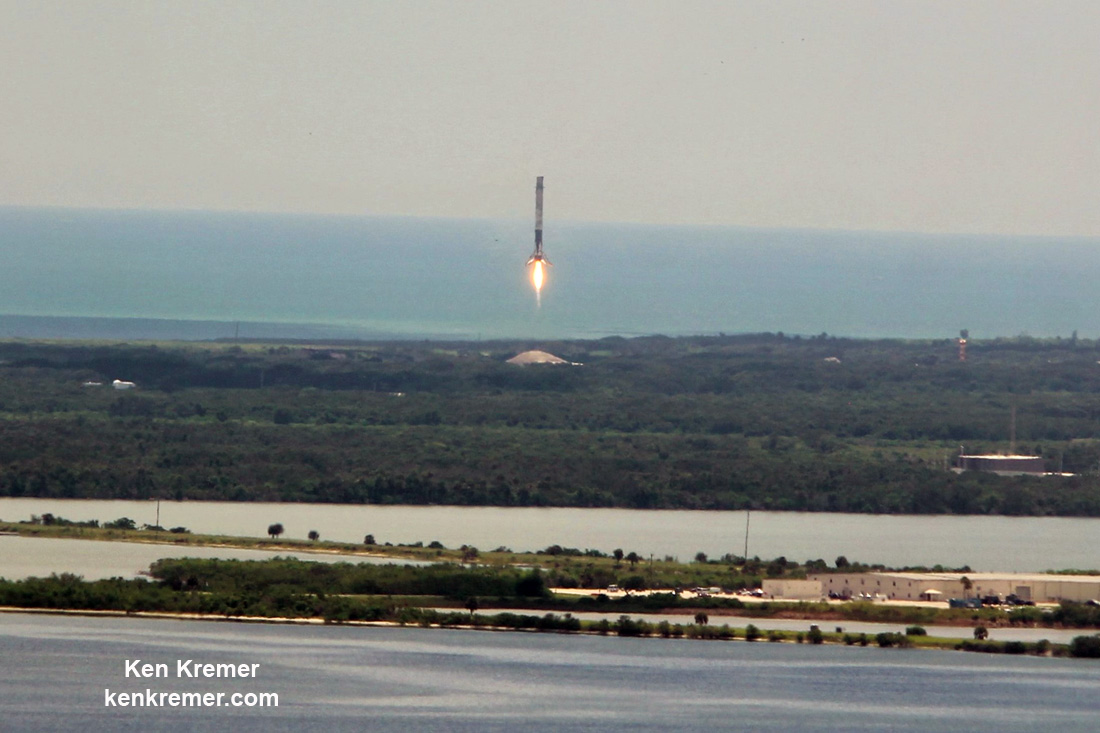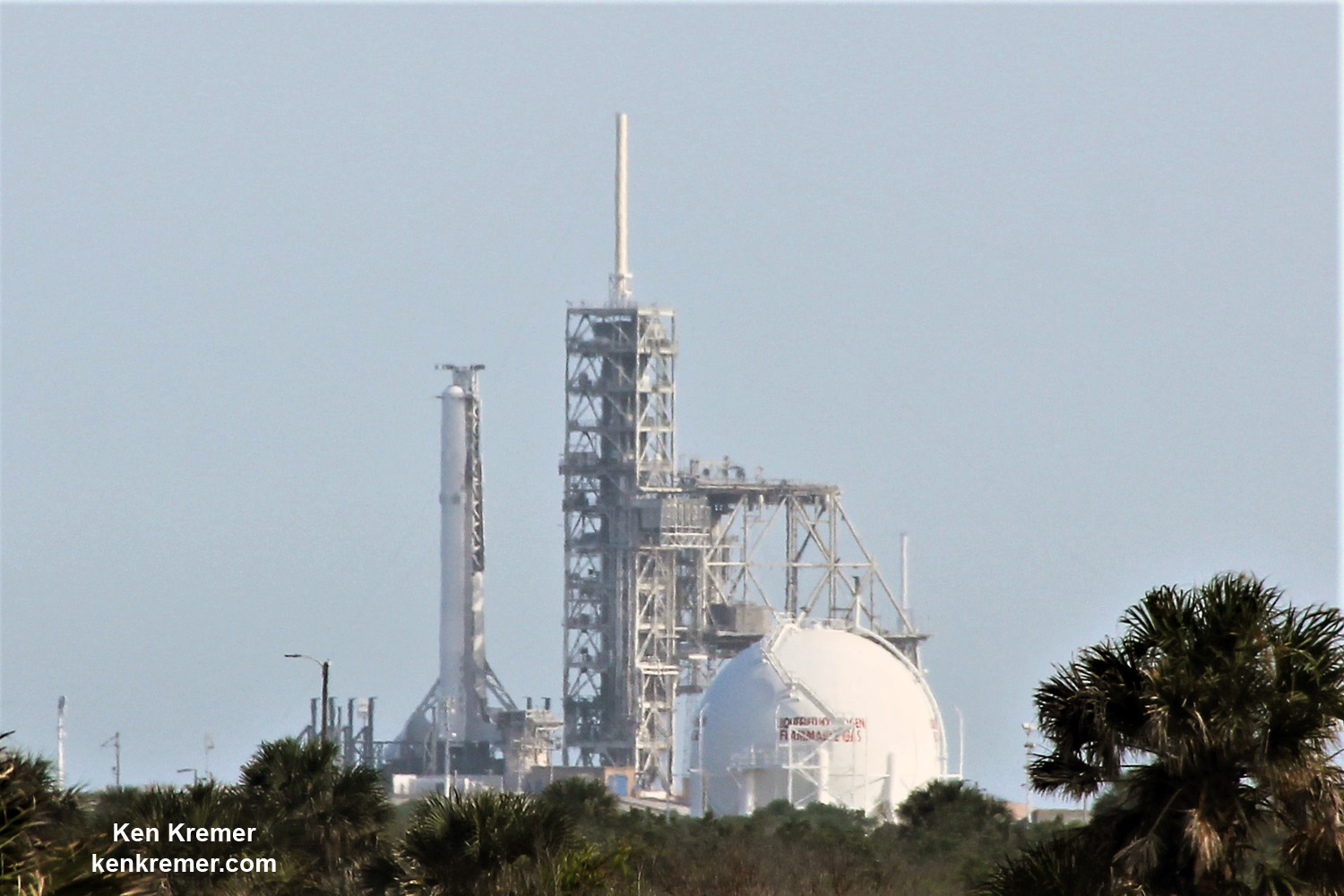
PLAYALINDA BEACH/KENNEDY SPACE CENTER, FL – Following a successful engine test firing of the Falcon 9 first stage late Thursday afternoon (Aug. 30), SpaceX is targeting a post Labor Day launch of the U.S. Air Force’s unmanned X-37B reusable mini-shuttle – a secretive technology testing spaceplane.
The brief but critical hold down engine test took place at 4:30 p.m. EDT (2030 GMT) Aug. 31 at Launch Complex 39A on NASA’s Kennedy Space Center – as witnessed live by myself and several spectators from nearby Playalinda Beach Causeway. See my photos herein.
Both SpaceX and the Air Force announced the target launch date after completion of the Aug. 31 engine test.
“Static fire test complete,” SpaceX confirmed via Twitter soon after completion of the test, “—targeting Falcon 9 launch of OTV-5 from Pad 39A at @NASAKennedy on Thursday, September 7.”
The routinely done static fire test and involves conducting a full launch dress rehearsal and countdown culminating with igniting all nine Merlin 1D first stage engines during a hold down test at the pad.

The Merlin’s generated a combined 1.7 million pounds of thrust and a huge exhaust plume billowing into the air from the north side flame trench during the test, which lasted several seconds.
The plume soon swirled overhead and dissipated about 10 minutes later. Ignition was accompanied by a loud roar we heard screaming out from the pad in all directions. A number of folks driving to and from Playalinda Beach had stopped to ask me what I was photographing prior to the test and stayed to witness the event.
The rocket will be lowered rolled back horizontally on the transporter erector into the SpaceX processing hangar and the spaceplane housed inside the payload fairing will be integrated on top. The full stack will then be rolled back out and erected at pad 39A.
The hold down test firing is carried out without the payload bolted on top inside the nose cone to keep it safe in the event of a catastrophic failure event such as occurred precisely 1 year ago – when a Falcon 9 blew up during fueling for similar engine test with the AMOS-6 satellite resulting in destruction of the rocket as well as the customers satellite hardware at pad 40.
The exact launch time had been a closely guarded secret – until this evening.
The X-37B launch is apparently lunchtime Thursday, September 7 at 12 PM – 12:01 PM, according to a Facebook post by the U.S. Air Force Space Command and the 45th Space Wing at Patrick Air Force Base, Fla., posted Friday evening.
“The Air Force Rapid Capabilities Office is undergoing final launch preparations for the fifth mission of the X-37B Orbital Test Vehicle [OTV],” the Secretary of the Air Force Public Affairs announced. “The OTV is scheduled to launch on Sept. 7, 2017, onboard a SpaceX Falcon 9 launch vehicle.

The X-37B will be launched for the fifth time on the OTV-5 mission atop a SpaceX Falcon 9 on Sept. 7 from Launch Complex 39A on the Kennedy Space Center Florida into low Earth orbit.
The Boeing-built X-37B is processed for flight at KSC using refurbished NASA space shuttle processing facilities now dedicated to the reusable mini-shuttle, also known as the Orbital Test Vehicle (OTV). It launches vertically like a satellite but lands horizontally like an airplane and functions as a reliable and reusable space test platform for the U.S. Air Force.
But in another first, the OTV-5 mission marks the first launch of an X-37B spaceplane by SpaceX.
All four prior OTV missions launched on the United Launch Alliance Atlas V and ended with runway landings in either California of Florida.
“The many firsts on this mission make the upcoming OTV launch a milestone for the program,” said Randy Walden, the director of the Air Force Rapid Capabilities Office.
“It is our goal to continue advancing the X-37B OTV so it can more fully support the growing space community.”
The OTV-4 mission launched on the ULA Atlas V on May 20, 2015 from Space Launch Complex-41, on Cape Canaveral Air Force Station.

After spending a record setting 718 days in orbit, the X-37B program completed its fourth mission with a runway landing back at KSC’s Shuttle Landing Facility on May 7, 2017. Overall OTV’s have spent a total of 2,085 days in orbit.

Playalinda Beach is located just 4 miles north of pad 39A and offers an excellent launch viewing location for the OTV-5 mission – if officials allow it to be open to the public.
The engine test comes at the end of a very busy August with a trio of Florida Space Coast launches plus a Total Solar ‘Eclipse Across America’ sandwiched in between.
Also noteworthy is that OTV-5 will be launched into a higher inclination orbit compared to the prior four, serve as a technology testbed for multiple research payloads and will also somehow deploy several small satellites or cubesats.
“The fifth OTV mission continues to advance the X-37B’s performance and flexibility as a space technology demonstrator and host platform for experimental payloads,” the USAF said in a statement.
“This mission carries small satellite ride shares and will demonstrate greater opportunities for rapid space access and on-orbit testing of emerging space technologies. Building upon the fourth mission and previous collaboration with experiment partners, this mission will host the Air Force Research Laboratory Advanced Structurally Embedded Thermal Spreader payload to test experimental electronics and oscillating heat pipe technologies in the long duration space environment.”

SpaceX will also attempt another land landing of the 156-foot-tall Falcon 9 first stage back at Landing Zone-1 (LZ-1) at the Cape.
The Falcon 9 first stage is equipped with a quartet of landing legs and grid fins to enable the rocket recycling plan.
“The fifth OTV mission will also be launched into, and landed from, a higher inclination orbit than prior missions to further expand the X-37B’s orbital envelope.”
The daylight first stage precision guided landing should offer spectators a thrilling up close view of the rocket reusability technology envisioned by SpaceX’s billionaire CEO Elon Musk to drastically slash the high costs of launching to space.

The 11,000 pound (4990 kg) state-of -the art reusable OTV space plane is about a quarter the size of a NASA space shuttle. The vehicle measures 29 ft 3 in (8.9 m) in length with a wingspan of 14 ft 11 in (4.5 m).
The X-37B was originally developed by NASA but was transferred to the Defense Advanced Research Projects Agency (DARPA) in 2004.
Since then most but not all of the spaceplane’s goals have been shrouded in secrecy.

Watch for Ken’s continuing onsite X-37B OTV-5 and NASA mission reports direct from the Kennedy Space Center and Cape Canaveral Air Force Station, Florida.
Stay tuned here for Ken’s continuing Earth and Planetary science and human spaceflight news.


